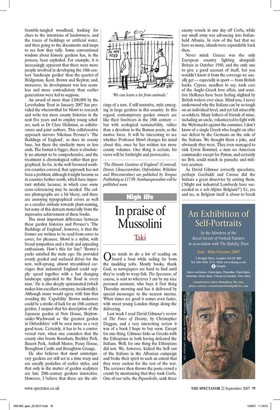Mowl's quest
Ursula Buchan It is more than 40 years since the foundation of the Garden History Society signalled that the study of the history of gardens and designed landscapes had become an important subject in its own right, instead of being simply an optional add-onto the study of historic buildings. Since then, our knowledge of the subject has increased exponentially, with academic research enlisted as a guide to preserving existing gardens, as well as uncovering those thought lost.
The trick, however, is how to ensure that knowledge of garden history, acquired in academic circles, filters out to the general reader, and there is none better at this than Timothy Mowl, who since 2002 has published six volumes of county garden history in his 'Historic Gardens of England' series.
Professor Mowl would seem to be almost uniquely qualified for the task, since he is director of one of only two MA courses in Garden History in this country, at the University of Bristol, as well as being the Professor of History of Architecture and Designed Landscapes, and director of the Institute for Landscape and Garden History. Bristol is presently the epicentre of academic study in the subject.
Mowl's approach is rigorously empirical. He is determined to tramp over every piece of uneven grassland and through every bramble-tangled woodland, looking for clues to the intentions of landowners, and the traces of buildings or artificial water, and then going to the documents and maps to see how they tally. Some conventional wisdom about historic gardens has, in the process, been exploded. For example, it is increasingly apparent that there were more people involved in developing the 18th-century 'landscape garden' than the quartet of Bridgeman, Kent, Brown and Repton; and, moreover, its development was less seamless and more contradictory than earlier generations were led to suppose.
An award of more than £300,000 by the Leverhulme Trust in January 2007 has provided the wherewithal for Mowl to research and write ten more county histories in the next five years and to employ young scholars, such as Dr Clare Hickman, as collaborators and joint authors. This collaborative approach mirrors Nikolaus Pevsner's 'The Buildings of England', as does its county base, but there the similarity more or less ends. The format is bigger, there is absolutely no attempt to be comprehensive, and the treatment is chronological rather than geographical. So far, in the well-favoured southern counties covered, that approach has not been a problem, although it might become so in counties further north, which have important stylistic lacunae; in which case some cross-referencing may be needed. The colour photographs are a bit blurry, and there are annoying typographical errors as well as a cavalier attitude towards plant-naming, but none of this detracts materially from the impressive achievement of these books.
The most important difference between these garden histories and Pevsner's 'The Buildings of England', however, is that the former are written to be read from cover to cover, for pleasure. Mowl is a stylist, with broad sympathies and a fresh and appealing enthusiasm. How's this for fun? 'Brown's parks satisfied the male ego. He provided evenly graded and surfaced drives for the new, well-sprung, almost streamlined carriages that industrial England could supply: speed together with a fast changing landscape appealed to the Toad in every man.' He is also deeply opinionated (which makes him excellent company, incidentally). Although many would agree with him that avoiding the 'Capability' Brown makeover could be a stroke of luck for an 18th-century garden, I suspect that his description of the Japanese garden at New House, Shiptonunder-Wychwood as 'the greatest garden in Oxfordshire' will be seen more as a very good tease. Certainly, it has to be a controversial view, when one considers that the county also boasts Rousham, Beckley Park, Buscot Park, Asthall Manor, Pusey House, Broughton Castle and Broughton Grange.
He also believes that most contemporary gardens are still set in a time warp and are usually pastiches of earlier styles, and that only in the matter of garden sculpture are late 20th-century gardens innovative. However, I believe that there are the stirrings of a new, if still tentative, style emerging in large gardens in this country. In this regard, contemporary garden owners are like their forebears in the 18th century — but with ecological sustainability, rather than a devotion to the Roman poets, as the motive force. It will be interesting to see whether Professor Mowl changes his mind about this, once he has written ten more county volumes. One thing is certain; his views will be forthright and provocative.
'The Historic Gardens of England' (Cornwall, Dorset, Gloucestershire, Oxfordshire, Wiltshire and Worcestershire) are published by Tempus Publishing at £17.99. Northamptonshire will be published soon.


































































 Previous page
Previous page